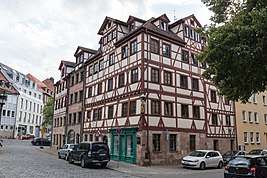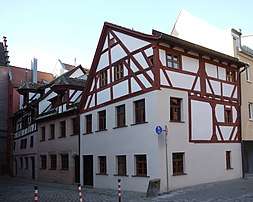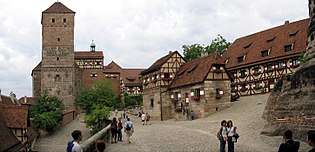Old Town Friends Nuremberg
The Old Town Friends Nuremberg (German: Altstadtfreunde Nürnberg e. V.) are an association that supports the preservation and restoration of the existing historical old town houses and other architectural monuments in Nuremberg that are worth preserving. Founded on January 25, 1950 under the name "Association of Friends of the Old Town Nuremberg". [1] The Old Town Friends grew from a small association with 135 members to their current size with about 6,000 members (status: 2002). This makes them the largest culturally active citizens' association in Nuremberg. [2] Since June 2010, the chairman is Karl-Heinz Enderle.
Activities
General

The association works to preserve the old town of Nuremberg, since the devastation it suffered in World War Two. It aims to ensure new building work is carried out that is in line with the old town. The old town friends also buy old town houses for this purpose - sometimes they get them through inheritance or donation - and renovate them. The association is committed to the preservation of monuments. Among other things, it works to try to highlight the history and importance of Nuremberg's old town to citizens and tourists . This happens through the old town walks (in which more than 250,000 people took part until 2002), group tours through the old town, active participation in the day of the open monument , monthly lectures and especially through the annual publication of the old town reports in Nuremberg. Between 1972 and 1978, the association achieved a groundbreaking success with the rescue of four medieval half-timbered houses on Unschlittplatz , which had already been released for demolition.
By 2002, the association had carried out 220 construction projects, including 38 half-timbered buildings , the preservation of nine houses through purchase and renovation, and eight others through resale. From 1973 to 2002, the Friends of the Old Town generated a total of over 15 million euros through these measures.
The influence of the association on the development of the city of Nuremberg was shown in the efforts of the old town friends to design the Augustinerhof in 1996. An architectural draft for this area in the centre of the old town - in the immediate vicinity of the main market was intended by the city planners of Nuremberg to give the city centre a "modern flair." In the opinion of the friends of the old town, the project was likened to a "sliced bratwurst" that would not have fit in the structural context of the old town of Nuremberg and its roof landscape. In a referendum, the first in a Bavarian city, voted on January 14, 1996 67,284 voters against the new construction project and only 30,637 for it, which prevented the implementation. In 2009, the association articulated its resistance to the new construction of the city library (including postcard campaign), which was unsuccessful.

In 2005 the Old Town Friends renovated three medieval craftsmen's houses (German: Handwerkerhäuser) from the 15th century on Kühnertsgasse. Since autumn 2011, the Old Town Friends have operated a museum in these buildings.
The Old Town Friends have done much work in restoring houses, especially in the street 'Weißgerbergasse' This street has around twenty medieval half-timbered houses[3] that survived the heavy air raids on Nuremberg.[4] It therefore reflects a piece of historic Nuremberg, in particular an old craft district within the Castle area. In the years around 1970, the half-timbering in the Weißgerbergasse was still plastered. The old friends helped renovate the houses Weißgerbergasse No. 23, 26, 30 and 35 to uncover their half-timbered facades and dormer windows.[5] On house numbers 16 and 25 on the street you can find two of the Nuremberg style "Chörlein", or bay windows, on the house facade, which loosened the strict image of the Nuremberg house facades. They also served to observe the street happenings.[6] The half-timbered excavations that the Old Town Friends brought about on the street was applauded by many, but others criticised it, arguing that the street had been turned into a showcase and a tourist attraction.
In 1997 the Old Town Friends bought the corner house Irrerstrasse 1, a former bath house from 1509. The house forms the entrance to Weißgerbergasse.[7] From 2004 - 2007 the Old Town Friends repaired the former bath house and restored the roof structure based on the historical model by removing its emergency post-war roof.[8]
Likewise, the Old Town Friends bought the historic former tanner's house at Weißgerbergasse 10 in 2000 and renovated it as an “Erich-Mulzer-Haus” with an expenditure of 1.5 million euros.[9] At the end of 2006 the Old Town Friends were able to put the roof bay on the house at Weißgerbergasse 8.[10]
Friends of the old town renovated the historic town house Weißgerbergasse 10 as "Erich-Mulzer-Haus" with an expenditure of 1.5 million euros and also set up their office there. For this purpose, the German Monument Protection Foundation contractually guaranteed a grant of 51,000 euros in July 2006, followed by two additional grants of the same amount.
The Old Town Friends renovated an old barn in Zirkelschmiedsgasse and have used it as an events location since around 2002.
The association is currently carrying out the reconstruction of the Pellerhof with donations and own funds. The inner courtyard of the Pellerhof was completed in 2018. The organisation is still pushing to reconstruct the complete building and the discussion about this is ongoing. The old town friends are also committed to moving the Neptune Fountain back to the main market .[11]
- Photographs of buildings associated with the organisation
 The former bathhouse on Irrerstrasse, Nuremberg.
The former bathhouse on Irrerstrasse, Nuremberg.- Weissgerbergasse 08, Nuremberg.
- Weissgerbergasse 10, Nuremberg.
- Weißgerbergasse, Nuremberg.
 The recently reconstructed Pellerhof Courtyard.
The recently reconstructed Pellerhof Courtyard.
Awards
- 1992 Prize of the Dr. Lorenz Tucher Foundation
- 2002 price in the facade competition of the Sparkasse Nürnberg, second price group (1,500 euros) for the half-timbered house Pfeifergasse 7
- 2002 Bavarian State Foundation Culture Award (25,000 euros)
- 2003 recognition (5,000 euros) for the town house Pfeifergasse 7 as part of the monument award of the Hypo-Kulturstiftung
- 2003 Award in the facade competition of the Sparkasse Nürnberg: Second place with 1,000 euros for the three-story house with gable in Mostgasse 9
- 2004 Bavarian developer award for urban renewal - vital inner city: recognition for Zirkelschmiedsgasse (Kulturscheune) and Pfeifergasse 7
Literature
- Erich Mulzer (2000), Michael Diefenbacher, Rudolf Endres (ed.), Altstadtfreunde, Nuremberg City Lexicon (Stadtlexikon Nürnberg) (in German) (2nd, revised ed.), Nuremberg: W. Tümmels Verlag, pp. 66 f., ISBN 3-921590-69-8
- Altstadtfreunde Nürnberg e.V. (Hrsg.): Altstadtmacher - 30 Jahre Altstadtfreunde Nürnberg, Redaktion: Inge Lauterbach, Text: Peter Fleischmann, Fotografien: Herbert Liedel, Bernd Telle, Günter Derleth. Nürnberg: Tümmels, 2003, 144 S., ISBN 3-921590-06-X
- Nürnberger Altstadtberichte. Jahresbericht und Aufsätze der Altstadtfreunde Nürnberg, hrsg. von den Altstadtfreunden Nürnberg e.V.; erscheint jährlich, Nr. 1 (1976), Nürnberg: Altstadtfreunde
- Wiltrud Fischer Pache: Nürnberger Altstadtberichte. Hrsg. von den Altstadtfreunden Nürnberg e.V., Nr. 14 (1989) 88 S., Nr. 15 (1990) 96 S., Nr. 16 (1991) 96 S., in: Mitteilungen des Vereins für Geschichte der Stadt Nürnberg Band 80, 1993, S. 273 - online
- Altstadtfreunde Nürnberg e. V. (2010), Kühnertsgasse 18-20 – Eine Reise durch die Jahrhunderte (in German), Nürnberg
References
- "Dr. Hellmut Kunstmann". Fränkische Schweiz - Verein e.V. Archived from the original on 2007-12-30. Retrieved 2010-12-09.
- Erich Mulzer gibt Vereinsvorsitz nach 30 Jahren ab. Die Altstadtfreunde bekommen eine Chefin, Inge Lauterbach at the Wayback Machine (archived 2007-09-27), Nürnberger Zeitung vom 8. April 2004
- Erich Mulzer: Der Nürnberger Fachwerkbau. In: Mitteilungen des Vereins für Geschichte der Stadt Nürnberg (MVGN), Band 55 (1967/68), Seite 300–331
- Presse- und Informationsamt der Stadt Nürnberg: Luftkrieg und Zerstörung in Nürnberg at the Wayback Machine (archived 2007-09-14)
- Abgeschlossene Bauprojekte der Nürnberger Altstadtfreunde - PDF
- H. Hedayati: Chörlein. Ein Spaziergang in der Nürnberger Altstadt.Archived 2018-03-23 at the Wayback Machine Juli 2004 (aktualisiert 2011)
- Haus Irrerstraße 1 - das ehemalige Irrerbad at the Wayback Machine (archived 2012-06-30)
- "ziegler-architekt: nurnberg badehaus". ziegler-architekt.de/. April 2020.
- Erich-Mulzer-Haus‘ geplant. In: Nürnberger Nachrichten vom 19. Januar 2006 at the Wayback Machine (archived 2007-12-30)
- "stadtbild-deutschland.org/". April 2020.
- Horn, Judith (April 2020). "Als Neptun noch auf dem Hauptmarkt thronte". nordbayern.de/region/nuernberg.
External links
- Altstadtfreunde Nürnberg e.V.
- Nürnberger Altstadtfreunde als Bauherren (PDF-Datei; 3,27 MB)
- Kühnertsgasse 18-22 auf www.altstadtfreunde-nuernberg.de
- Handwerkerhäuser in der Kühnertsgasse sind fertiggestellt auf www.nz-online.de
- Altstadtfreunde Nürnberg: Weißgerbergasse 10 - das Dr.-Erich-Mulzer-Haus
- Ziegler Arkitekt: Badehaus
